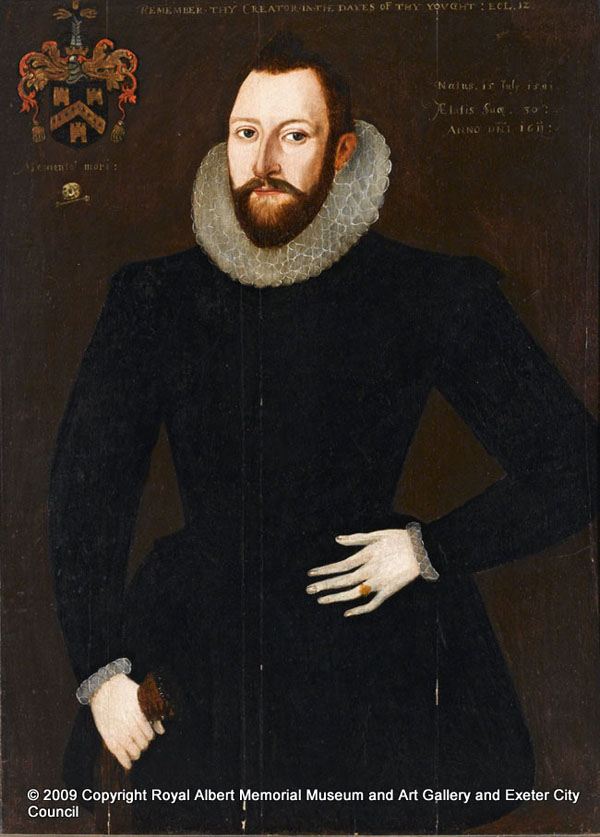Case Study 13: Nicholas Spicer, Merchant and Mayor of Exeter (1581-1647) by an anonymous artist of the English school 1611
“Nicholas Spicer was a merchant and freeman of Exeter who held the office of Mayor in 1603-1604, 1629-1630 and 1644-1645.
He was the son of Christopher Spicer and his wife Elizabeth (nee Symonds). He was born on 15 July 1581 (1) and christened in St, Martin’s Church, Exeter, two days later (2). His sister, Elizabeth, was born in 1587 and married Thomas Flaye. (See her separate entry under Elizabeth Flaye.) Nicholas Spicer was twice married, first in 1602 to Joan Horsey and, secondly in 1627 to Martha Preistly [sic]. Between them they produced a large family of at least nine children – two sons and seven daughters (3).
Spicer was a member of the Exeter Society of Merchant Adventurers. Cotton tells us that he served as its Governor (4). His career as a merchant adventurer can be pieced together from his will proved in 1647 (5). He described himself as a merchant of Exeter, giving details of his property in the city, but his interests were firmly rooted in the City of London. He directs that he should be buried in the parish church of St.Mary Aldermary ‘as neere unto my late brother Richard Spicer Dr. of phisicke dec[ease]d. as conveniently may be.’ One hundred pounds of the five hundred he bequeathed to his wife, Martha, would be paid to her ‘immediately after the adventures I have abroad shall come in and my debts be received.’ The reference to his other house at Greenwich hints at his sea-borne interests.
The will contains some detail of the furniture Spicer bequeathed to his widow and children. To his wife he left ‘the Scratorie [possibly a writing desk], the Chest of drawers, the great spruce chest in my lodging Chamber and a chest in the furthest Chamber of my house at Greenwich.’ His daughter Priscilla was to receive ‘my Pironndes suite of chayres & stooles w[hi]ch was her mothers and a needleworke cushion, and to my daughter Martha one needleworke cushion, with my stamll imbrodred suite of Chayres and stooles. And to my daughter Abigail my greene imbroydered suite of Chayres and stooles.’ Meanwhile his younger son Thomas was to inherit ‘the Tables Bedsteads shelves and other necessaries w[hi]ch my father left in’ the house in Exeter then let to Henry Prigg.
Nicholas Spicer supported the Royalist cause during the Civil War. The account of his pardon, received posthumously on the payment of a fine in 1648, described his offence as being ‘in Arms against the Parliament’ (6).
This painting with its symbols and inscriptions of death belongs to a group known as memento mori portraits. As a group they have recently been the subject of an extensive study by Dr. Tarnya Cooper of the University of Sussex. The significance of the year 1611 has not been established; his first wife died a few years later, but it is possible that there is a link to Nicholas Spicer ‘the eldest” who died in that year (7). He was a long-serving alderman of the City of Exeter and the founder of Spicer’s Charity, which still exists.
Shortly after the municipal reforms of 1832 the Corporation disposed of the painting, presenting it to ‘representatives of the family’. In 1853 it was said to have ‘been removed to Courtlands [presumably a seat of the Spicers] since 1836’ (8). In 1978 it was purchased by RAMM, prior to which cleaning had found that the arms had been altered (9).”
Author: Stephen Price
Footnotes
- Inscription on the painting
- IGI
- Ibid.
- William Cotton An Elizabethan Guild of the City of Exeter: An Account of the Proceedings of the Society of Merchant Venturers during the latter half of the 16th. Century (Exeter, William Pollard, 1873)
- TNA PCC PROB11/120: Will of Nicholas Spicer, Alderman of Exeter, Devon, 14 November 1612
- Journal of the House of Commons vol.6 1802 for 4 September 1648 p.4
- TNA PCC PROB11/200: Will of Nicholas Spicer, Merchant of Exeter, Devon, 28 June 1647
- George Oliver & Pitman Jones Description of the Guildhall, Exeter (Exeter, William Roberts, 1853) p.26; Beatrix F. Creswell “The Exeter Bond of Association” in TDA 44 1912 p. 273
- Exeter Museums Bulletin no 46 April 1979. Apparently in 1620, at the Herald’s Visitation to Devonshire, the Garter King of Arms granted an alteration to the arms of Nicholas Spicer, replacement of the crest of the arms. Thus the ‘Stork in his proper colours holding in his beak a branch of 3 green nutmegges with maces’ became ‘our of a mural crown a cubit arm vested proper, the hand holding a fire-ball sable, flames proper.’

